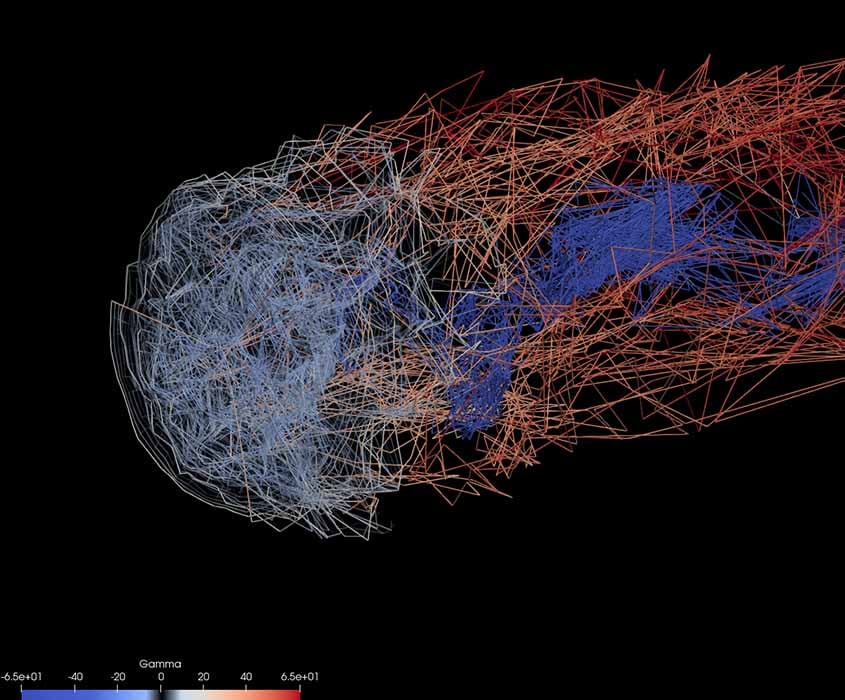BAR: Big Adaptive Rotor Project
The BAR project investigates design approaches for large-scale land-based wind turbine rotors, including aerodynamic performance, structural characteristics, and manufacturing considerations.

This visualization shows the wake behind a lightweight, slender, and highly flexible wind turbine rotor designed at NLR to simulate the next generation of land-based wind turbines. The wake was generated by running the aero-servo-elastic framework OpenFAST, its free-wake vortex model OLAF, and the geometrically exact beam model BeamDyn. Photo by Pietro Bortolotti, National Laboratory of the Rockies
The past few decades have seen substantial reductions in the cost of wind energy. One key factor behind this trend has been the increase in average rotor size. Larger rotors capture more energy while limiting costs, such as operation and maintenance and balance of stations. Low-specific-power turbines—i.e., relatively larger rotors on the same machine rating—increase capacity factors and the availability of wind power.
The U.S. Department of Energy's BAR project conducted several investigations to support large land-based wind turbines. Investigating technology innovations such as highly flexible blades, controlled bending of components during rail transportation, distributed aerodynamic control, and novel materials in manufacturing will make it easier to harness the country's abundant wind and produce energy that is more affordable. To support these studies, the numerical tools are also improved, verified, and validated.
Project Outline
BAR Phase II pursues this mission by conducting work in three focus areas, which are represented by three tasks:
- The first task aims to show the value and unresolved challenges of flexible blades and distributed aerodynamic control devices. Task 1 activities will be described in upcoming technical reports.
- In the second task, NLR researchers are advancing the state of the art of numerical models that simulate wind turbines, both at the single turbine level and within a wind farm. Efforts are being dedicated to accurately model the complex deformations and the unsteady aerodynamic effects experienced by highly flexible blades. Work is conducted in two of NLR's OpenFAST modules, BeamDyn and AeroDyn15.
- The third and last task conducts three experiments about aeroelastic stability of wind turbines, a downwind rotor experiment, and a structural experiment at coupon, subcomponent, and scaled blade levels. Task 3 also provides support to the project Rotor Aerodynamics, Aeroelastics and Wake project. The ultimate goal of Task 3 is to provide validation data for the new suite of advanced engineering design tools developed within the BAR project.
Phase I: Coding Advances
To help clarify and better articulate the science and engineering hurdles facing potential turbine concepts, researchers have been extending the modeling capabilities of a variety of NLR's numerical tools. Improvements have been implemented in aeroservoelastic model OpenFAST, conceptual technology design framework Wind-Plant-Integrated System Design and Engineering Model, turbine Reference OpenSource Controller, and the novel design framework Wind Energy with Integrated Servo-control. All these tools can help improve technology performance and turbine system-level interactions.
BAR researchers have also developed cOnvecting LAgrangian Filaments, a new free-vortex wake module included in NLR's OpenFAST wind turbine simulation tool. The models the turbine wake using particles connected via filaments and is programmed to generate realistic representations of large, flexible turbine blades, providing users an alternative to traditional, lower-fidelity aerodynamic models. As an open-source, mid-fidelity tool, cOnvecting LAgrangian Filaments enables designers throughout the wind industry to more accurately and predictably model their own designs, reducing their development costs, while further developing the software collaboratively.
The BAR project funded improvements to detailed, cross-sectional analysis solver ANBA4 and composite blade mesh tool Structural Optimization and Aeroelastic Analysis. These two tools are under active development.
The BAR project started in 2018 and its first phase concluded in 2021. An NLR report summarizes all the key findings obtained during BAR Phase I.
Phase II: Maturing Technology Readiness
BAR is now in Phase II, which focuses on the techno-economic assessment, detailed design, and experimental validation necessary to further mature the technology readiness level of very large, rail-transportable blade designs identified in BAR Phase I as promising technologies for the next-generation of land-based wind turbines.
BAR Phase II focuses on techno-economic assessment, detailed design, and experimental validation of highly flexible, downwind, and distributed aerodynamic control technologies for large-scale wind turbines.
Collaboration and Team Members
Finally, BAR seeks strong collaborative engagement with industry stakeholders and holds quarterly meetings with an external advisory board formed of industry experts to collect feedback and disseminate results. The project involves researchers from NLR and Sandia National Laboratories.
NLR
Co-Project Lead: Pietro Bortolotti
NLR research engineers include:
- Mayank Chetan
- Derek Slaughter
- Emmanuel Branlard
- Chris Ivanov
- Andy Platt
- Jason Jonkman
- Jason Roadman
- Scott Dana
- Derek Berry
- Scott Hughes.
Sandia National Laboratories
Co-Project Lead: Josh Paquette
Sandia National Laboratory research engineers include:
- Evan Anderson
- Ernesto Camarena
- Chris Kelley.
Contact
Share
Last Updated Dec. 7, 2025
